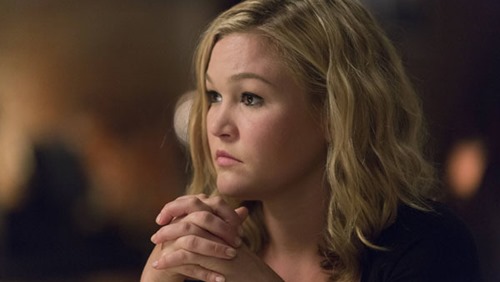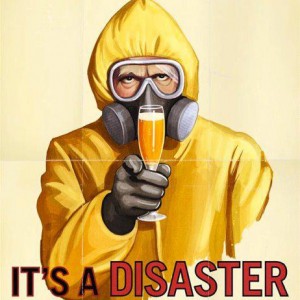Written by Katherine Murray.
Blue is either an amazing bait-and-switch or (more likely) a series that changed its mind about what it was partway through. Either way, what began as an inferior, online version of Secret Diary of a Call Girl, has grown into a powerful, subtle, and well-acted drama about the long-term effects of sexual abuse, and the shadow that misogyny and the threat of violence casts over women’s sexuality in general. It’s also a big achievement for the WIGS channel, whose mission is to create more female-led programming.

I wouldn’t blame you if you’ve never heard of Blue – I hadn’t heard of it until CTV starting promoting it as part of its online video service this winter. The series began life in 2012 as a group of short webisodes on the WIGS YouTube channel, before switching to an hour-long format and moving to Hulu in its third season (in Canada, it’s now on CTV Extend, along with several other WIGS series).
WIGS, in itself, is pretty cool. It’s a free, online channel that offers original programming, focused on female leads. In addition to Julia Stiles, who plays the title role in Blue, WIGS has produced shorts and web series led by Anna Paquin, Jenna Malone, and America Fererra, among others. Blue seems to be the one that’s got the most traction, and it’s fair to say that it’s WIGS’ flagship show.
The premise of Blue (and it’s not a great premise, so bear with me for a minute) is that Stiles’ character is a single mom who sometimes resorts to prostitution in order to make ends meet. All of the commercials and advertising for the show feature a clip from the series’ first webisode, where Blue, in sexy lingerie, explains to a client, “I gotta provide.” During the early episodes, there’s a sense that Blue is going to play out a lot like Secret Diary of a Call Girl – that is, it seems like the point of the show is to voyeuristically peer inside a middle class version of sex work. We watch Blue interact with a wide range of clients who are all set apart by peculiar habits and fetishes, and we watch her cagily hide this part-time job from everyone else in her life. It seems, at first, like the only major conflict the show’s setting up is a love interest slash frenemy of Blue’s who learns the truth about her job, and might spill the beans to her family. Otherwise, the story doesn’t seem like it’s going anywhere until late in the first season, when suddenly it goes everywhere – to places I haven’t seen many shows go at all, let alone in such an honest, thoughtful way.

Late in season one, after some foreshadowing has prepared us, we learn that Blue was sexually abused by one of her mother’s boyfriends when she was in middle school, and that there’s a good chance that guy is the father of her son. That revelation cracks the story wide open and, from that point forward, Blue is a lot less about watching Julia Stiles be sexy, and a lot more about watching her struggle with the long term effects of trauma – the way it interferes with her relationships, the way her lack of boundaries shapes the dynamic she has with her son, the way she blocks things out and dissociates under stress.
Blue is a series that builds up slowly, over time, rather than dropping everything on us at once. The complex social and psychological dynamics between the characters are like sediment, accumulating layer by layer, until the third season feels like a careful, complex dissertation on human behaviour.
When Blue’s abuser returns to the picture, it’s disturbing that she doesn’t stand up to him – that he still has so much power over her – but it’s also realistic. So is the way he explains, with no trace of shame, anger, or guile, that he didn’t do anything wrong, and he’s the real victim, because she’s let other people convince her that he’s a bad person, when they both know the truth is different.
The show also takes its time in revealing how Blue’s own memory of these events is fragmented and hard for her to access. In one scene, she’ll struggle to remember anything about her childhood, and come up short on details when someone asks. In another, she’ll have a sudden emotional outburst, as she remembers that her mother betrayed her trust by leaving her alone with the man who raped her. After that, she’ll forget the outburst happened, and wonder why her son suddenly seems to be so careful and delicate about her feelings.
Depicting a character who doesn’t have a constant sense of self and doesn’t understand her own feelings, or remember her own experiences consistently, requires a great deal of patience and restraint on the part of the writers, directors, and actor. Julia Stiles has always been a pretty understated actor, and it works for her, here, as a character who’s built a protective shell so strong that it separates her from her own emotions. Blue never tells us how to interpret the characters’ feelings, but it has a keen eye for detail in how trauma can be expressed through words and behaviour, and there’s at least one sequence in which sound and video editing are used to create a pretty convincing impression of dissociation, which no explanation needed.

In the third season, Blue expands its view of female sexuality through two new characters: Blue’s sister Lara, and Lara’s girlfriend, Satya. Season three is a winner on all counts, but the introduction of these characters allows the show to add a few more layers to its sediment, and flesh out the themes that are already there.
Satya, played by Canadian singer-songwriter Alexz Johnson, is a bad news musician who systematically leaches off her partners in lieu of getting a job. When we meet her, she’s leaching off Lara (which means leaching off Blue, by proxy), and trying to track down a lowlife who owes her some money. The most terrifying scene in the show comes where Satya and Lara confront the lowlife’s friends, looking for the money he owes them, and realize too late that they’re in a locked apartment with guys who want to rape them. The scene is a lot more low-key that what you’d get on HBO, but that’s what makes it scary – a normal conversation suddenly tips into something more sinister, and, before anyone makes a move toward them, Lara runs to the door and starts screaming for help.
It’s a moment that’s powerful and disturbing, and underscores the threat of violence that runs underneath interactions between men and women. When I started writing this review, I was going to say, “Blue is bad at being a show about prostitution, but it’s good at being a show about sexual violence” – in retrospect, I think maybe it’s good at being a show about prostitution because it’s good at being a show about sexual violence, and presenting a world where no one’s choices are ever fully disentangled from the misogynist threads in our culture.
There’s an argument that says, in order to be sex-positive people, we need to stop stigmatizing prostitution, and challenge the idea that women only get into sex work because they’ve been kidnapped, coerced, or abused – that we instead need to promote the empowering idea that women can be sex workers because they choose to be, in an utterly untroubled way. And, while it’s true that some people get into sex work without any trauma or exploitation and, while I’m happy for them if they have a positive experience, the reality is that, at this point in history, most prostitutes don’t enter the profession because things are going so well in their lives. While it’s fine to have Secret Diary of a Call Girl – while that’s a legitimate experience that can be explored – it’s also important to keep telling stories like this – stories that highlight how even sex work that looks, on the surface, like it’s voluntary, is still an artefact of the same culture in which women are disproportionately the victims of sexual assault and domestic violence. Sex work doesn’t exist in a separate reality where none of the other bullshit about sex and gender affects what goes on.
On a less ideological level, Blue also pulls off a pretty risky narrative feat by building up Satya’s talent all season long – telling us that she’s this amazing musician, who’s obviously special, and captivates you as soon as you hear her play – and then delivering on that promise, when Johnson sings a song that she wrote for the show in a clear, strong voice that instantly shows us why all of these characters see something special in Satya. That doesn’t seem like such a hard thing to pull off, but look at all the times Smash and Glee tried to tell us that someone was good at singing, and see how that turned out.
If you are intrigued by complex characterization, explorations of sexual violence, or convincingly good singer-songwriter stuff, you can catch up on Blue at the WIGS website, on Hulu in the United States, or on CTV Extend in Canada.
Katherine Murray is a Toronto-based writer who yells about movies and TV on her blog.








